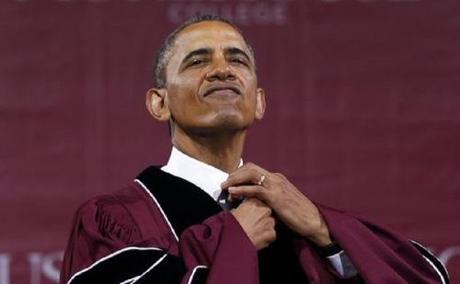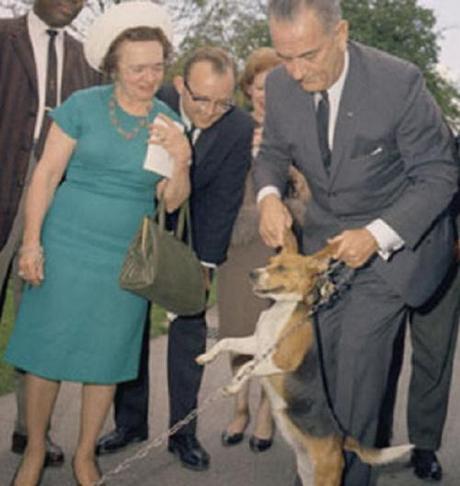
No, it’s not Barack Obama, although we all know he would win that dubious distinction, hands down.
That’s because the psychologists who did the study oh-so-conveniently excluded the POS from its rating.
Rich Morin reports for Pew Research Center, Nov. 14, 2013, that Lyndon Johnson leads the list of 42 presidents on measures of “grandiose narcissism,” according to a new study by a team of psychologists published online by the journal Psychological Science.
Obama was not rated.
The top ten most narcissistic presidents and their political party IDs are:
- Lyndon Johnson (D)
- Teddy Roosevelt (R)
- Andrew Jackson (D)
- Franklin D. Roosevelt (D)
- John F. Kennedy (D)
- Richard Nixon (R)
- Bill Clinton (D)
- Chester A. Arthur (R)
- Andrew Johnson (D)
- Woodrow Wilson (D)
The ten least narcissistic presidents are:
33. James Garfield (R)
34. William McKinley (R)
35. Rutherford B. Hayes (R)
36. James Madison (Democratic Republican)
37. William Howard Taft (R)
38. Calvin Coolidge (R)
39. Ulysses S. Grant (R)
40. Grover Cleveland (D)
41. James Monroe (Democratic Republican)
42. Millard Fillmore (Whig)
The researchers also found that, unsurprisingly, presidents on average are more narcissistic than the average American. Moreover, presidents are getting more and more grandiosely narcissistic in recent decades.
Grandiose narcissism is a distinctive type of narcissism characterized by exhibitionism, attention-seeking, inflated demands of entitlement and denial of weaknesses.
To compile their rankings of most and least grandiosely narcissistic presidents, these researchers assembled data from three major sources:
1. The heart of their analysis is data collected as part of an earlier study of the personality characteristics of all U.S. presidents through Bill Clinton, which they supplemented with data on George W. Bush. For this earlier study, 120 “expert raters” evaluated presidents by filling out standardized personality tests, using their knowledge of the presidents to inform their answers. The raters included historians, presidential biographers and other scholars. For each president that fell within their area of expertise, these raters answered nearly 600 questions on the personality and behavior of their president or presidents. The questionnaire included measures that are used to diagnose various psychological conditions, including grandiose narcissism. Separate questions assessed other aspects of presidential character including unethical behavior.
(A caveat: Comparing one president’s ranking with another should be done cautiously because raters only evaluated presidents they were knowledgeable about and not all first executives. Beyond that, these ratings are based, in part, on personal opinions, albeit the judgments of well-informed experts—another reason for caution.)
2. The research team supplemented these data with historical surveys of presidential performance. They included a 2009 C-SPAN survey of 64 historians who rated the presidents on 10 dimensions, including overall job performance, persuasiveness and crisis management. They also analyzed a 2010 Siena College survey of 238 historians who ranked the presidents on 20 dimensions of performance and an academic study summarizing a dozen rankings of the presidents.
3. Finally they added object measures of presidential performance to this statistical stew. These included overall share of the vote, number of terms and total years served, scandals in office and whether the president was subject of one or more congressional impeachment resolutions.
The research team found that a generous helping of inflated self-worth is like a double-edged sword in that grandiosity has both positive and negative effects on a presidency:
- On the one hand, Ashley L. Watts and her colleagues found grandiose narcissism was associated with “superior overall greatness” as measured by historians’ rankings of presidential stature and “positively associated with public persuasiveness, crisis management, agenda setting and allied behaviors.” And when they looked at objective measures of presidential performance, researchers found that grandly narcissistic presidents won a larger share of the vote and initiated more legislation than less self-infatuated first executives.
- But there’s also a dark side to grandiose narcissism. Leaders ranking higher on this narcissism measure also were more likely to be the targets of impeachment resolutions (Richard Nixon stood sixth on the list, just behind Kennedy) and engage in unethical behavior (Bill Clinton ranked seventh).
The researchers also ran their data by using the index to clinically diagnose narcissistic personality disorder (NPD). No matter. Lyndon Johnson still leads the presidential pack, again finishing first on the NPD index.
Here’s the list:


Boston University history professor Robert Dallek undertook 14 years of research for his two-volume biography of Lyndon B. Johnson, Flawed Giant. In an article for The Atlantic, “Three New Revelations About LBJ,” Dallek described Johnson as “urinating in a sink, inviting people into his bathroom, showing off his abdominal scar, exposing his private parts.”
Since pathological narcissists have constructed a grandiose false self, they are alienated from their true self. Beneath their arrogant strutting veneer, narcissists actually feel empty inside.
Johnson was no different. His press secretary Bill Moyers said Lyndon Johnson had “an unfillable hole in his ego.” Feelings of emptiness spurred him to eat, drink, and smoke to excess. Sexual conquests also helped to fill the void. He was a competitive womanizer. When people mentioned John F. Kennedy’s many affairs, Johnson would bang the table and declare that he had more women by accident than Kennedy ever had on purpose.
~Eowyn

